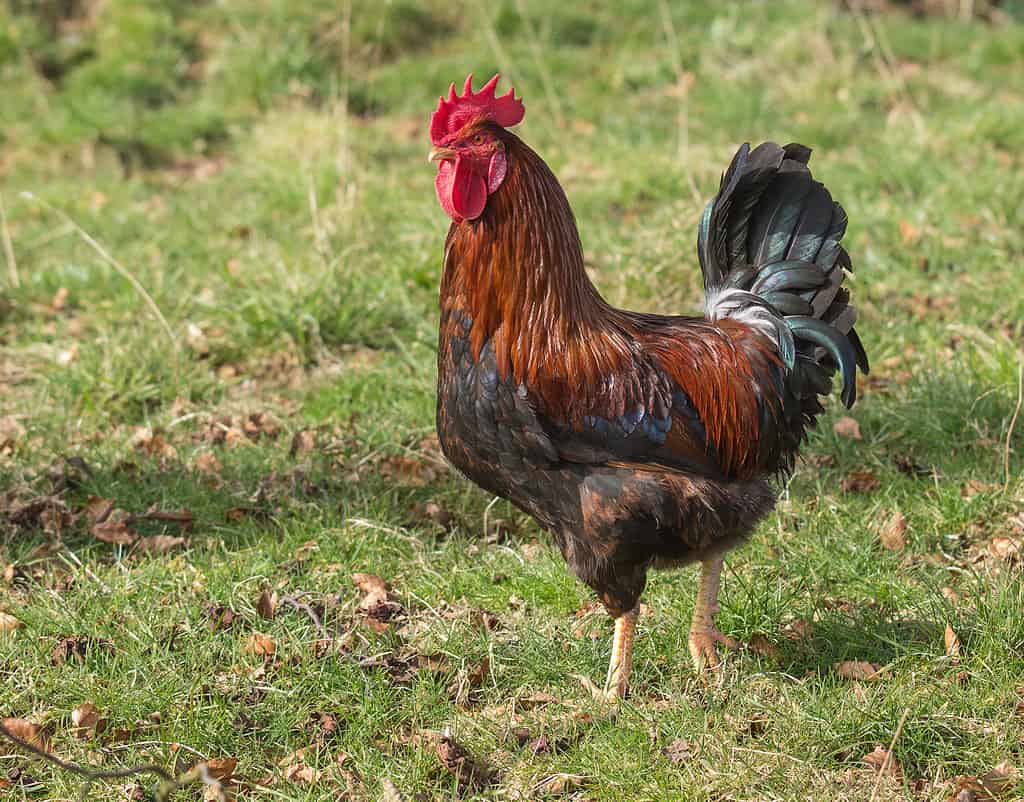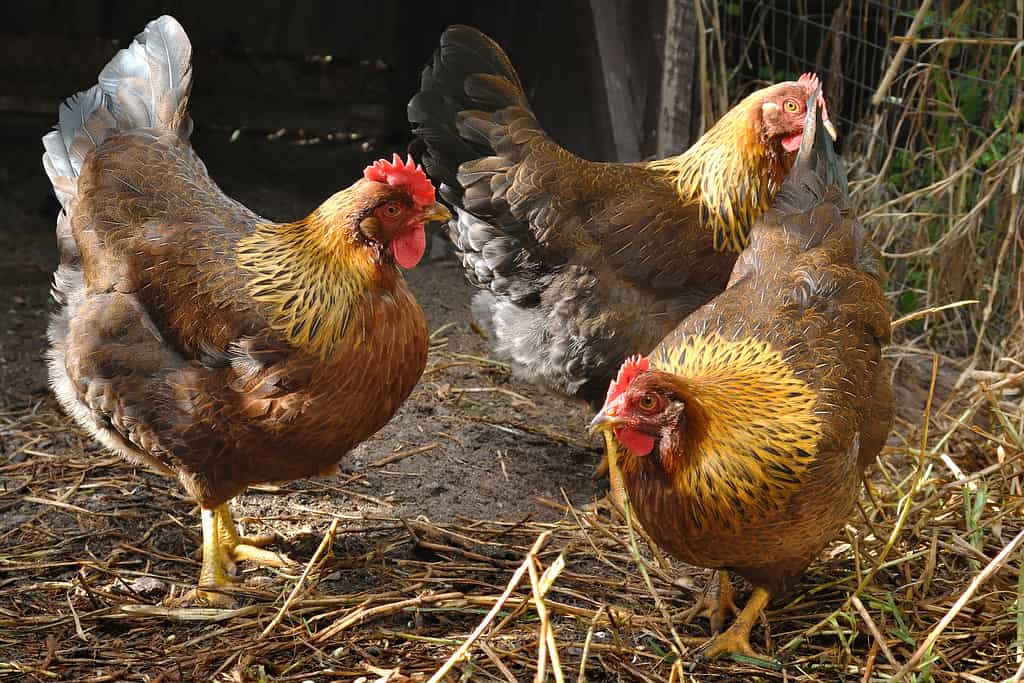Welsummer chickens are relative newcomers to the poultry scene. This breed originated in The Netherlands around a century ago with the Dutch standard set in 1924. Named after the Dutch village of Welsum where it first appeared, the Welsummer chicken has traits from several older breeds. According to the Poultry Club of Great Britain, the Welsummer descended from “such breeds as the partridge Cochin, partridge Wyandotte and partridge Leghorn, and still later the Barnevelder and the Rhode Island Red.” The Welsummer Club in Great Britain was formed in 1930 to promote the new breed. The club lists King Charles III as its patron.
The Welsummer chicken breed exhibits considerable sexual dimorphism. You may find the males familiar. The rooster on the box of Kellogg’s Corn Flakes was modeled after a Welsummer. Hens, though not as vibrantly patterned, are just as beautiful. Read on to learn more about the Welsummer hen vs. rooster and discover the differences for yourself.
Welsummer Hen vs. Rooster: Size
Welsummer chickens are among the medium-sized chicken breeds. Both hens and roosters have an upright stance with their heads generally held erect. They have rather compact bodies, broad with long backs, and though they do not reach great heights their stately posture gives them a tall appearance. Welsummer hens reach approximately 6 pounds. Welsummer roosters, when fully grown, weigh in at about 7 pounds.
Bantam-sized Welsummer chickens are much smaller than their full-sized counterparts. These diminutive chickens hover close to 2 pounds. Bantam Welsummer hens usually weigh about 30 ounces, while bantam Welsummer roosters reach only approximately 34 ounces.
Welsummer Hen vs. Rooster: Plumage
The American Poultry Association recognizes only one variety of Welsummer chickens, the partridge. Silver duckwing and gold duckwing varieties are also recognized across parts of Europe, although only the partridge variety is recognized by officials in the Welsummer’s home of the The Netherlands.
Welsummer roosters of the partridge variety should have an underlying rich golden-brown color. Their golden-brown hackles should be as uniform as possible, but some birds may have black striping among these feathers. Bright, reddish-brown feathers should cover the back and shoulder. Welsummer roosters have black breasts, slightly mottled with red feathers. Their wings are multicolored, featuring black feathers with a striking green sheen. The tail also has sleek, black feathers with a bright green sheen.

Welsummer roosters have a green sheen on their black feathers.
©Nigel Spooner/iStock via Getty Images
Welsummer hens are more uniformly reddish-brown, with subtle variations on different parts of their bodies. They exhibit the standard partridge marking on their back and wings, having reddish-brown feathers, lighter along the shaft, with each feather finely stippled with black specks. The plumage on a Welsummer hen’s head has a golden glow, while the hackles may appear golden or coppery. Hackle feathers closer to the base of the neck should be striped with black and have lighter golden shafts. Hens have rich reddish-brown breasts. Their backs and wings also feature reddish-brown plumage with partridge markings. The wings also have brown and some black feathers, while their upright tails feature black feathers marked with brown.

Welsummer hens have larger combs and wattles than many other hens.
©illarionovdv/iStock via Getty Images
Silver duckwing-colored Welsummer roosters have white feathers whereas the partridge variety has golden brown or reddish brown. Hens of the silver duckwing variety have silvery white feathers on their heads and necks. They have pinkish-red breasts and silvery feathers interspersed over their bodies. Gold duckwing Welsummer chickens are rare. The roosters have similar plumage to the silver duckwing but with golden feathers of various shades in place of white.
Autosexing
Welsummer chickens are among the few chicken breeds that are autosexing. This means that, thanks to their genetic makeup, owners can tell which chicks are males and which are females immediately after they hatch. Most chickens can’t be sexed until much later. Welsummer chicks have yellow feathers with brown patches when they hatch, and if the owner knows what to look for, they can tell which is a baby hen and which is a baby rooster. Females have darker heads with clear stripes down their backs and sharply outlined eyes. The patterns on males are much less distinct, almost fuzzy, and they have lighter heads.
Welsummer Hen vs. Rooster: Other Physical Characteristics
Welsummer roosters have medium, bright red, single combs with five to seven points. They also have medium-sized, bright red wattles and red earlobes. They have a long neck, an upright tail, and a long, flat back. This gives their body a U-shape. They have strong, yellow, clean shanks and feet with four long toes.
Welsummer hens also have bright red, serrated, single combs, red wattles, and red earlobes. Their combs and wattles, though smaller than those of the roosters, appear larger than those of many similarly sized hens. Welsummer hens also have a somewhat U-shaped body, with an upright tail and long neck, though neither measures up to those of the roosters. They, too, have yellow legs and feet with four toes.
Welsummer Hen vs. Rooster: Temperament
Welsummer chickens are generally friendly, calm, and even docile. Neither the hens nor the roosters prefer to be picked up and cuddled. However, they do tolerate handling fairly well and make decent backyard pets for beginner chicken keepers or families with children. Welsummer chickens are intelligent birds. They enjoy foraging and ranging freely, but they will tolerate being kept in runs as long as they are provided with adequate space.
Welsummer hens do not tend to go broody often, and owners insist that they have poor maternal instincts.
Welsummer Hen vs. Rooster: Egg and Meat Production
As a dual-purpose breed, Welsummer chickens were originally bred for both meat and egg production. The hens lay between about 160 to 200 large eggs per year. This number does not come close to comparing with the best egg-producing breeds, but owners do not mind. Welsummer hens are valued for the rich, deep, terracotta brown eggs they produce. These eggs, sometimes speckled with brown, have more of a reddish tint than the deep chocolate eggs of the Marans chicken. The color is deposited on the shells of the eggs just before the hen lays them, so owners must take care not to rub it off.
Welsummer roosters grow slower than many other breeds, and they don’t get as big as the heavy breed chickens. But owners attest that these qualities make the meat of the Welsummer chicken taste much better. The roosters have a relatively low fat content and a deep, meaty breast. Thanks to their easygoing nature they are easy to raise to a good size for roasting.
A Welsummer Summary
Here is a summary of the differences between Welsummer hens and roosters. This breed expresses significant sexual dimorphism. Roosters have dramatic, multicolored plumage with a metallic green sheen on their black breast and tail feathers. Hens have pretty, patterned individual feathers, but they look more uniform than the males. Both sexes have a majestic, upright posture and feature bright red, single combs with clearly defined points. Both sexes have bare, yellow legs and feet with four long toes. Thanks to autosexing genes, Welsummer hens and roosters are easy to tell apart from the very beginning.
| Hens | Roosters | |
|---|---|---|
| Size | Up to 6 pounds | Up to 7 pounds |
| Plumage | Mostly reddish-brown or golden-brown feathers with individual patterns; upright tail | Multicolored with reddish-brown base; black breast and tail with a bright green sheen; black feathers in wings |
| Other Traits | Medium-sized, bright red, single comb, larger than hen’s, with 5-7 points; bright red wattles and red earlobes | Medium sized, bright red, single comb, larger than hen’s, with 5-7 points; bright red wattles and red earlobes |
| Temperament | Friendly, calm, and docile; tend not to go broody; reportedly bad mothers | Friendly, calm, and docile; generally not aggressive; prefers not to be picked up |
| Production | Medium-sized, bright red, single comb with clearly defined points; bright red wattles and red earlobes | Tasty meat with low fat content; deep, extra meaty breast |
The photo featured at the top of this post is ©
Thank you for reading! Have some feedback for us? Contact the AZ Animals editorial team.







